The Game Phases
Contents
There are three phases in most Go games. In the opening, both players scope out the territory which they wish to develop. In the middle game, territory is contested for and fighting over an area usually occurs. In the endgame, groups have been developed, territory has been secured and the players compete for the last few points remaining on the board. This lesson will give some examples of each of the phases and briefly explain the principles behind them.
The Opening
Return to TopAn opening pattern is commonly called a fuseki. Here we will look at a few popular fuseki and explain what they aim at.
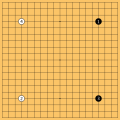
Dia. 1: The nirensei fuseki.
The first example is called the nirensei fuseki (dia. 1). In Japanese, nirensei means (roughly) "two star points in a row." It became popular in the 1930's and involves playing two corner starpoints on one side of the board. It does not secure the corners entirely, but aims for quick development across the borad.
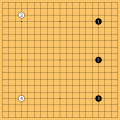
Dia. 2: The sanrensei fuseki.
The sanrensei fuseki (dia. 2) is also popular. Sanrensei means "three star points in a row" in Japanese. It focuses on influence towards the centre more than territory, because the three black stones support each other and will be useful during fighting.
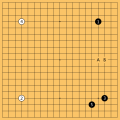
Dia. 3: The orthodox fuseki.
The orthodox fuseki (dia. 3) is another common fuseki. It balances territory (the enclosure) and influence (the 4-4 stone). Black would benefit from a strong framework on the right side, so White's next move is usually there.
It can be challenging to learn all the principles behind the opening phase. In general, remember to play "big" moves and avoid creating weak groups. If you have weak groups (with no base or eyespace), they might be attacked while your opponent strengthens their own stones.
The Middle Game
Return to TopThe middle game usually begins when both players want one part of the board, and a fight occurs. It is difficult to give specific examples as every game is different, but here are some general ideas.

Dia. 4: The shoulder hit.
The shoulder hit (dia. 4) is a stone which diagonally approaches an enemy stone on the third line. It is useful when reducing the opponent's influence and increasing your own. In the diagram, Black will usually defend at A or B in response to White's shoulder hit. In most cases, it is bad to ignore a shoulder hit and play elsewhere.
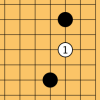
Dia. 5: Invasion of a three space extension.
Invasions occur in most games. There are many ways to invade an opponent's potential territory. An invasion of a three space extension (dia. 5) is common. There are many variations here. The purpose of an invasion is to enter a new area, but it important to plan ahead and make sure your invasion is not helping your opponent secure an even large area neraby.
The middle game is often complicated, and fights are common. You must consider the positions of stones across the entire board when playing. Try to remember what you have learned about shape and frameworks, and try to attack the opponent while strengthening your own positions.
The Endgame
Return to TopIn the endgame, most areas have already been established and the last points on the board are contested. It is important to play moves worth the most points, and which your opponent has to respond to ("sente" or "forcing moves"). That way you can play another forcing move and gain even more points.
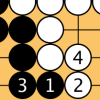
Dia. 6: Endgame example where White has to respond (move 4).
In the endgame, look for sente moves (dia. 6) and play them first. In the diagram, White blocks Black 1 with 2. Black defends the stone with 3, and White defends the cut with 4. Because White played last, Black can now play another endgame move elsewhere.
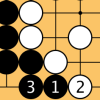
Dia. 7: Endgame example where Black has to respond (move 3)
Try to avoid gote moves (dia. 8) until there are no more sente moves remaining. "Gote" is the opposite of "sente" - your opponent does not need to respond and will take sente. In the diagram, Black defends 1 with 3, and White can play elsewhere.
Conclusion
Return to TopThe information provided here is very brief, but at this level you should have a basic understanding of the different game phases. A general rule is, "play urgent moves before big moves." Try not to create weak groups in the opening, make good shape in the middle game, and play sente moves in the endgame.
For further review, some study problems about the game phases (and other "intermediate" topics on this website) are available.
Suggested Reading
Return to Top- In the Beginning by Ishigure Ikuro 9p.
- Modern Joseki and Fuseki: Volume 2: The Opening Theory of Go by Sakata Eio 9p.
- Learn to Play Go Series Volume IV (Battle Strategies) by Jeong Soo-Hyun 9p and Janice Kim 3p
- The Endgame by Tomoko Ogawa 6p and James Davies.